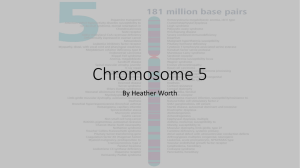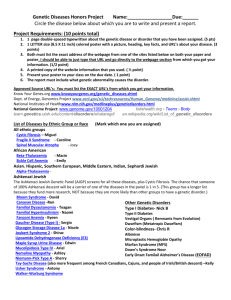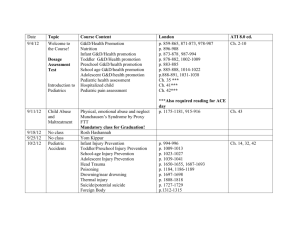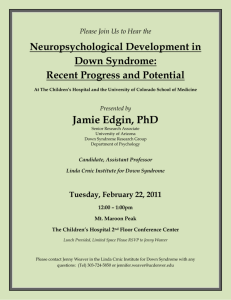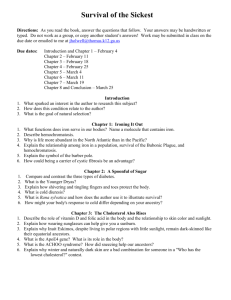HUMAN GENOMICS
advertisement
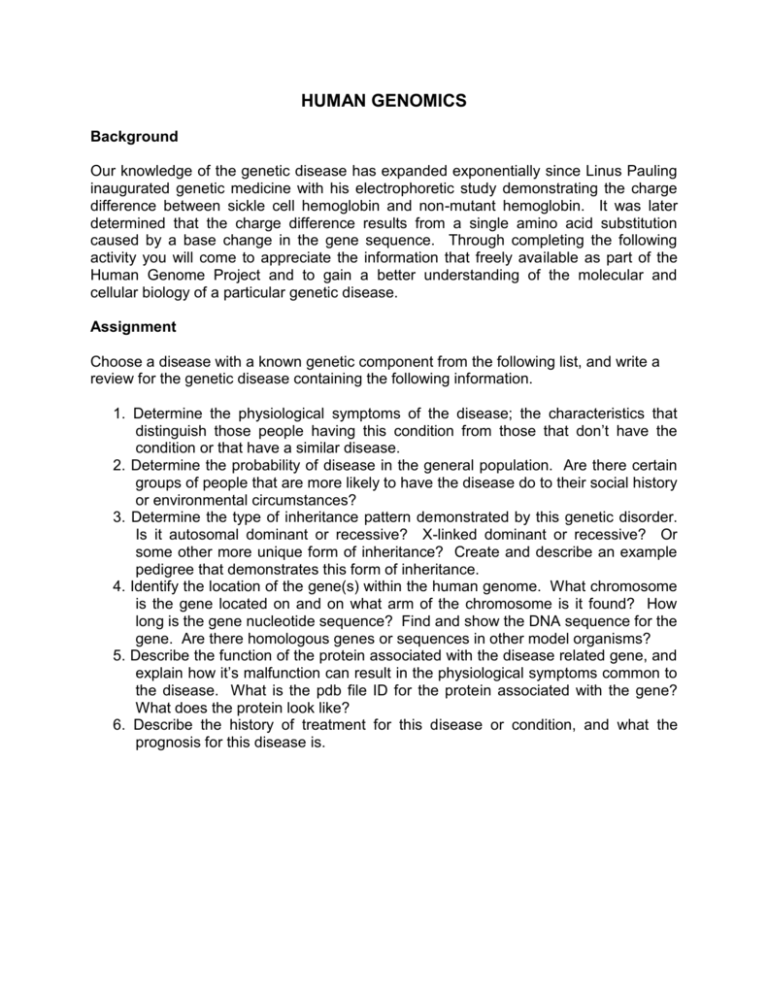
HUMAN GENOMICS Background Our knowledge of the genetic disease has expanded exponentially since Linus Pauling inaugurated genetic medicine with his electrophoretic study demonstrating the charge difference between sickle cell hemoglobin and non-mutant hemoglobin. It was later determined that the charge difference results from a single amino acid substitution caused by a base change in the gene sequence. Through completing the following activity you will come to appreciate the information that freely available as part of the Human Genome Project and to gain a better understanding of the molecular and cellular biology of a particular genetic disease. Assignment Choose a disease with a known genetic component from the following list, and write a review for the genetic disease containing the following information. 1. Determine the physiological symptoms of the disease; the characteristics that distinguish those people having this condition from those that don’t have the condition or that have a similar disease. 2. Determine the probability of disease in the general population. Are there certain groups of people that are more likely to have the disease do to their social history or environmental circumstances? 3. Determine the type of inheritance pattern demonstrated by this genetic disorder. Is it autosomal dominant or recessive? X-linked dominant or recessive? Or some other more unique form of inheritance? Create and describe an example pedigree that demonstrates this form of inheritance. 4. Identify the location of the gene(s) within the human genome. What chromosome is the gene located on and on what arm of the chromosome is it found? How long is the gene nucleotide sequence? Find and show the DNA sequence for the gene. Are there homologous genes or sequences in other model organisms? 5. Describe the function of the protein associated with the disease related gene, and explain how it’s malfunction can result in the physiological symptoms common to the disease. What is the pdb file ID for the protein associated with the gene? What does the protein look like? 6. Describe the history of treatment for this disease or condition, and what the prognosis for this disease is. Genetic Diseases Sickle cell anemia Gaucher Disease Chronic myeloid leukemia Paroxysmal nocturnal hemoglobinuria Thalassemia Ovarian Cancer Lung Carcinoma Multiple Endocrine Neoplasia Tumor Suppressor p53 Polycystic Kidney Disease Harvey Ras Oncogene Tuberous Sclerosis Crohn’s Disease Diabetes, Type I Wilson’s Disease Best Disease Gyrate Atrophy of the Choroid and Retina Pendred Syndrome Adrenal Hyperplasia, congenital Autoimmune Polyglandular Syndrome Diastrophic Dysplasia Ataxia telangiectasia Long QT Syndrome Asthma Immunodeficiency with Hyper-Ig-M Alport Syndrome (M) Achondroplasia Charcot-Marie-Tooth Syndrome Ellis-van Creveld Syndrome Marfan Syndrome Angelman Syndrome Prader-Willi Syndrome Werner Syndrome LaFora Disease Familial Mediterranean Fever Gaucher Disease Lesch-Nyhan Syndrome Menkes Syndrome Parkinson Disease Refsum Disease Spinocerebellar Ataxia Tay-Sachs Disease Obesity Wolf-Hirschhorn Syndrome Burkitt Lymphoma Hemophilia A Niemann-Pick Disease Porphyria Breast Cancer Colon Cancer Malignant Melanoma Neurofibromatosis Pancreatic Cancer Prostate Cancer Retinoblastoma Von Hippel-Lindau Syndrome Cystic Fibrosis Glucose Galactose Malabsorption Zellweger Syndrome Glaucoma Deafness Rett Syndrome (F) Adrenoleukodystrophy Cockayne Syndrome Multiple Endocrine Neuplasia Atheriosclerosis Williams Syndrome DiGeorge Syndrome Severe Combined Immunodeficiency Male Pattern Baldness (M) Amyotrophic Lateral Sclerosis Duchenne Muscular Dystrophy Fibrodysplasia Ossificans Progressiva Myotonic Dystrophy Fragile X Syndrome Waardenburg Syndrome Alzheimer Disease Essential Tremor Friedreich’s Ataxia Huntington Disease Maple Syrup Urine Disease Narcolepsy Phenylketonuria Spinal Muscular Atrophy Tangier Disease Hereditary Hemochromatosis Alpha-1-Antitrypsin Deficiency Web Materials Entrez, The Life Sciences Search Engine http://www.ncbi.nlm.nih.gov/Entrez/ Human Genome Project Genetic Diseases http://www.ornl.gov/sci/techresources/Human_Genome/medicine/assist.shtml http://www.ornl.gov/sci/techresources/Human_Genome/posters/chromosome/diseaseindex.shtml KU Med Center Genetic & Rare Conditions Site http://www.kumc.edu/gec/support/ Genes & Disease http://www.ncbi.nlm.nih.gov/books/bv.fcgi?call=bv.View..ShowSection&rid=gnd.preface.91 Dolan DNA Learning Center’s Your Genes Your Health http://www.ygyh.org/ Ask the Geneticist http://www.askthegen.org/ Genetics Home Reference http://ghr.nlm.nih.gov/ Online Books http://www.ncbi.nlm.nih.gov/entrez/query.fcgi?db=Books Online Mendelian Inheritance in Man http://www.ncbi.nlm.nih.gov/entrez/query.fcgi?db=Books GenBank http://www.ncbi.nlm.nih.gov/entrez/query.fcgi?db=Nucleotide Gene Homologs http://www.ncbi.nlm.nih.gov/entrez/query.fcgi?db=homologene Protein Databank http://www.rcsb.org/pdb/Welcome.do http://www.ncbi.nlm.nih.gov/entrez/query.fcgi?db=Protein PubMed Central http://www.ncbi.nlm.nih.gov/entrez/query.fcgi?db=pmc
